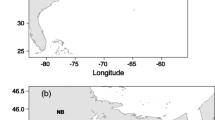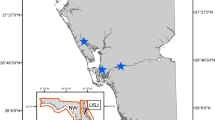Abstract
Sawfish are a group of endangered elasmobranchs that were common in tropical inshore, estuarine and freshwaters. The demography of two species of sawfish that occur in the western Atlantic – Pristis pectinata and P. perotteti – was investigated using age-structured life tables. Life history parameters for use in the life tables were obtained from published data. Five scenarios were tested for P. pectinata to incorporate uncertainties about life history data. Values of intrinsic rate of increase ranged from 0.08 to 0.13 yr−1, and population doubling times from 5.4 to 8.5 yrs. Eight scenarios were tested for P. perotteti. The most likely range for the intrinsic rate of increase was 0.05–0.07 yr−1, with population doubling times of 10.3–13.5 yrs. Four scenarios investigating the sensitivity to methods of estimating natural mortality produced similar results. The demographic results were sensitive to changes in reproductive periodicity and natural mortality. The results indicate that if effective conservation plans can be implemented for sawfish and sawfish habitats, recovery to levels where there is little risk of extinction will take at least several decades.
Similar content being viewed by others
References cited
Au, D.W. & S.E. Smith. 1997. A demographic method with population density compensation for estimating productivity and yield per recruit of the leopard shark (Triakis semifasciata). Can. J. Fish. Aquat. Sci. 54: 415–420.
Baillie, J & B. Groombridge. 1996. IUCN Red List of threatened animals. IUCN, Cambridge. 448 pp.
Baughman, J.L. 1943. Notes on sawfish, Pristis perotteti Muller and Henle, not previously reported from the waters of the United States. Copeia 1943: 43–48.
Bigelow, H.B. & W.C. Schroeder. 1953. Sawfishes, guitarfishes, skates and rays. Fisheries of the Western North Atlantic. Memoirs of the Sears Memorial Foundation for Marine Research 1: 1–514.
Cailliet, G.M. 1992. Demography of the central California population of the leopard shark (Triakis semifaciata). Aust. J. Mar. Freshw. Res. 43: 183–193.
Cailliet, G.M., R.L. Radtke & B.A. Welden. 1986. Elasmobranch age determination and verification: a review. pp. 344–360. In: T. Uyeno, R. Arai, T. Taniuchi & K. Matsuura (ed.) Indo-Pacific Fish Biology: Proceedings of the Second International Conference on Indo-Pacific Fishes. Ichthyological Society of Japan, Tokyo.
Camhi, M. 1998. Sharks on the line. A state-by-state analysis of sharks and their fisheries. National Audubon Society, New York. 156 pp.
Cole, G.A. 1976. Limnology of the great lakes of Nicaragua. pp. 9–15. In: T.B. Thorson (ed.) Investigations of the Ichthyofauna of Nicaraguan Lakes. School of Life Sciences, University of Nebraska-Lincoln, Lincoln.
Cortes, E. 1995. Demographic analysis of the Atlantic sharpnose shark, Rhizoprionodon terraenovae, in the Gulf of Mexico. U.S. Fish. Bull. 93: 57–66.
Cortes, E. 1998. Demographic analysis as an aid in shark stock assessment and management. Fish. Res. 39: 199–208.
Crooks, K.R., M.A. Sanjayan & D.F. Doak. 1998. New insights on cheetah conservation through demographic modeling. Conserv. Biol. 12: 889–895.
Crouse, D.T., L.B. Crowder & H. Caswell. 1987. A stage-based population model for loggerhead sea turtles and implications for conservation. Ecology 68: 1412–1423.
Henshall, J.A. 1895. Notes on fishes collected in Florida in 1892. Bulletin of the U.S. Fish Commission 14(1894): 209–221.
Hoenig, J.M. 1983. Empirical use of longevity data to estimate mortality rates. U.S. Fish. Bull. 82: 898–903.
Hoenig, J.M. & S.H. Gruber. 1990. Life-history patterns in the elasmobranchs: implications for fisheries management. pp. 1–16. In: H.L. Pratt Jr., S.H. Gruber & T. Taniuchi (ed.) Elasmobranchs as Living Resources: Advances in the Biology, Ecology, Systematics and the Status of the Fisheries, NOAA Tech. Rep. NMFS 90.
Jensen, A.L. 1996. Beverton and Holt life history invariants result from optimal trade-off of reproduction and survival. Can. J. Fish. Aquat. Sci. 53: 820–822.
Jordan, D.S. & B.W. Evermann. 1896. The fishes of North and Middle America. Bull. U.S. Nat. Mus. Number 47, Part 1, Volume 1: 1–954.
Krebs, C.J. 1985. Ecology: the experimental analysis of distributions and abundance. Harper and Row, New York. 694 pp.
Last, P.R. & J.D. Stevens. 1994. Sharks and rays of Australia. CSIRO, Melbourne. 513 pp.
Pauly, D. 1980. On the interrelationship between natural mortality, growth parameters, and mean environmental temperatures in 175 fish stocks. Journal du Conseil International pour l'Exploration de la Mer 39: 175–192.
Peterson, I. & J.S. Wroblewski. 1984. Mortality rates of fishes in the pelagic ecosystem. Can. J. Fish. Aquat. Sci. 41: 1117–1120.
Simpfendorfer, C.A. 1999a. Demographic analysis of the dusky shark fishery in south-western Australia. pp. 149–160. In: J.A. Musick (ed.) Life in the Slow Lane: Ecology and Conservation of Long-lived Marine Animals, American Fisheries Society Symposium 23, Bethesda.
Simpfendorfer, C.A. 1999b. Mortality estimates and demographic analysis for the Australian sharpnose shark, Rhizoprionodon taylori from Northern Australia. U.S. Fish. Bull. 97 (in press).
Sminkey, T.R & J.A. Musick. 1996. Demographic analysis of the sandbar shark, Carcharhinus plumbeus, in the western North Atlantic. U.S. Fish. Bull. 94: 341–347.
Tanaka, T. 1991. Age estimation of freshwater sawfish and sharks in northern Australia and Papua New Guinea. University Museum, University of Tokyo, Nature and Culture (3): 71–82.
Thorson, T.B. 1976. Observations on the reproduction of the sawfish, Pristis perotteti, in Lake Nicaragua, with recommendations for its conservation. pp. 641–650. In: T.B. Thorson (ed.) Investigations of the Ichthyofauna of Nicaraguan Lakes, School of Life Sciences, University of Nebraska-Lincoln, Lincoln.
Thorson, T.B. 1982a. Life history implications of a tagging study of the largetooth sawfish, Pristis perotteti, in the Lake Nicaragua-Rio San Juan system. Env. Biol. Fish. 7: 207–228.
Thorson, T.B. 1982b. The impact of commercial exploitation on sawfish and shark populations in Lake Nicaragua. Fisheries 7: 2–10.
Thorson, T.B., C.M. Cowan & D.E. Watson. 1966. Sharks and sawfish in the Lake Izabal-Rio Dulce system, Guatemala. Copeia 1966: 620–622.
Author information
Authors and Affiliations
Rights and permissions
About this article
Cite this article
Simpfendorfer, C.A. Predicting Population Recovery Rates for Endangered Western Atlantic Sawfishes Using Demographic Analysis. Environmental Biology of Fishes 58, 371–377 (2000). https://doi.org/10.1023/A:1007675111597
Issue Date:
DOI: https://doi.org/10.1023/A:1007675111597




